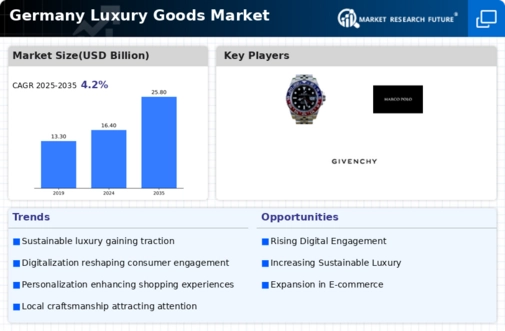Rising Affluence and Wealth Concentration
The luxury goods market in Germany is experiencing a notable surge due to the rising affluence among consumers. As wealth concentration increases, a growing segment of the population is able to afford high-end products. According to recent data, the number of high-net-worth individuals in Germany has increased by approximately 8% over the past year. This demographic shift is driving demand for luxury goods, as affluent consumers seek exclusive products that reflect their status. The luxury goods market is thus benefiting from this trend, as brands tailor their offerings to meet the desires of wealthier consumers. Furthermore, the increase in disposable income allows for greater spending on luxury items, which is expected to continue fueling market growth in the coming years.
E-commerce Expansion and Digital Engagement
The luxury goods market in Germany is witnessing a significant transformation due to the expansion of e-commerce and digital engagement strategies. With an increasing number of consumers preferring online shopping, luxury brands are investing heavily in their digital platforms. Recent statistics indicate that online sales in the luxury goods market have grown by 15% in the last year alone. This shift not only enhances accessibility for consumers but also allows brands to engage with their clientele through personalized online experiences. The integration of advanced technologies, such as augmented reality and AI-driven recommendations, further enriches the shopping experience. As a result, the luxury goods market is likely to see sustained growth as brands adapt to the evolving digital landscape.
Experiential Luxury and Lifestyle Integration
The luxury goods market in Germany is evolving towards experiential luxury, where consumers seek not just products but immersive experiences. This trend indicates a shift in consumer preferences, as individuals increasingly value lifestyle integration over mere ownership of luxury items. Brands are responding by offering exclusive experiences, such as private events, personalized services, and unique travel opportunities. Recent surveys suggest that approximately 60% of luxury consumers in Germany prefer experiences over products, indicating a significant opportunity for brands to innovate. The luxury goods market is thus adapting to this demand by creating memorable experiences that resonate with consumers' aspirations. This focus on experiential luxury is expected to drive growth and foster brand loyalty in the coming years.
Sustainability and Ethical Consumption Trends
Sustainability is becoming a pivotal driver in the luxury goods market in Germany, as consumers increasingly prioritize ethical consumption. The demand for environmentally friendly products is reshaping the market landscape, with many consumers willing to pay a premium for sustainable luxury items. Recent studies indicate that around 70% of luxury consumers in Germany consider sustainability when making purchasing decisions. This trend compels brands within the luxury goods market to adopt sustainable practices, such as using eco-friendly materials and ensuring ethical labor practices. As awareness of environmental issues continues to rise, brands that successfully align their values with those of conscious consumers are likely to gain a competitive edge and foster long-term loyalty.
Cultural Heritage and Craftsmanship Appreciation
In Germany, there is a growing appreciation for cultural heritage and craftsmanship, which significantly influences the luxury goods market. Consumers are increasingly drawn to products that embody traditional craftsmanship and local artistry. This trend is reflected in the rising demand for luxury items that showcase unique designs and high-quality materials. The luxury goods market is responding by emphasizing the stories behind their products, highlighting artisanal techniques and sustainable sourcing. This focus on heritage not only appeals to consumers' desire for authenticity but also supports local artisans and manufacturers. As a result, brands that successfully communicate their commitment to craftsmanship are likely to thrive in the competitive landscape of the luxury goods market.

















